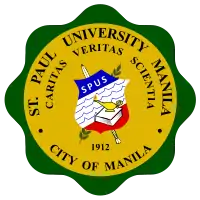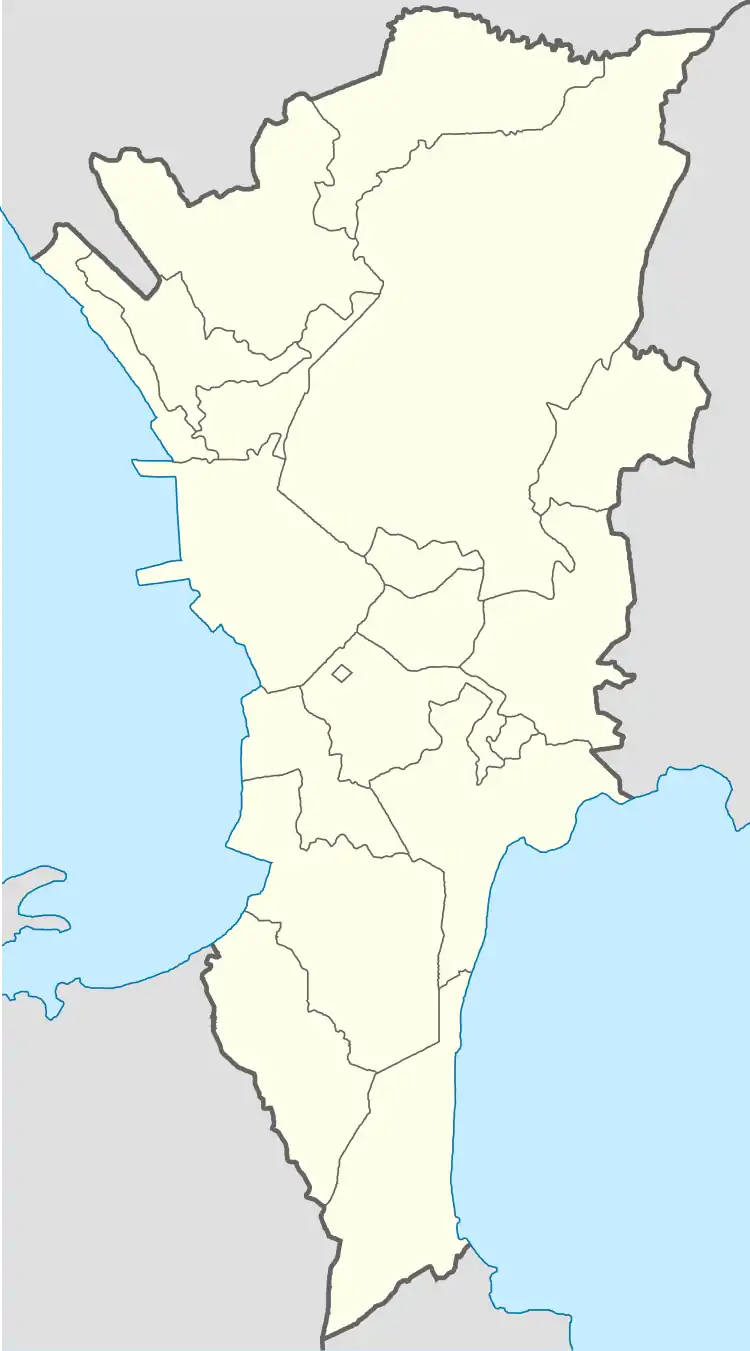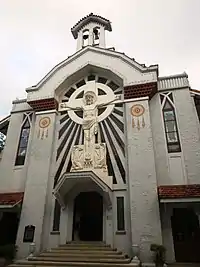St. Paul University Manila
St. Paul University Manila, also referred to as SPUM or SPU Manila, is a private, Catholic coeducational university. It was previously an all-girls' school and turned co-ed beginning school year 2005-2006.[1] The college was established in 1912 by the Sisters of St. Paul of Chartres (SPC),[2] a Congregation founded in Chartres, France in 1698
 | |
Former names | St. Paul Institution (1912-) St. Paul College of Manila |
|---|---|
| Motto | Caritas Christi Urget Nos (Latin) |
Motto in English | The charity of Christ urges us |
| Type | Private Roman Catholic research non-profit coeducational Basic and Higher education institution |
| Established | 1912 |
| Founder | Congregation of the Sisters of Saint Paul 0f Chartres |
Religious affiliation | Roman Catholic Sisters of St. Paul of Chartres |
Academic affiliations | SMIIC |
| President | Sr. Ma. Evangeline Anastacio, SPC |
| Vice-president | Ma.Encarnacio Dychangco (VP for Academic Services) Joanne Popanes (VP for Student Services) Sr. Jesusa Taccad, SPC (VP for Chritian Formation) Sr.Alegria Avellaneda, SPC (VP for Administrative Services) Sr. Ruby Abellana, SPC (VP for Finance Services) |
| Location | , , 14°34′27″N 120°59′10″E |
| Campus | Urban |
| Álma Mater song | The Paulinian Hymn |
| Colors | Green and Gold |
| Nickname | Paulinians |
| Website | www |
 Location in Metro Manila .svg.png.webp) St. Paul University Manila (Luzon) .svg.png.webp) St. Paul University Manila (Philippines) | |
On October 29, 1904, seven Sisters of the Congregation of the Sisters of St. Paul of Chartres, France established its first foundation in the Philippines in Dumaguete, Negros Oriental, Philippines.[3] The Sisters, coming from their mission in Vietnam, responded to the invitation of Bishop Frederick Rooker of the Diocese of Iloilo, to which Dumaguete then belonged. The seven Sisters were Mother Marthe de St. Paul, Superior, Sr. Marie Louise du Sacre Coeur, Sr. Ange Marie, Sr. Anne de la Croix, Sr. Charles de Genes, Sr. Catherine, and Sr. Josephine. St. Paul’s College, Dumaguete was founded as St. Paul Academy, becoming the first St. Paul’s College in the Philippines[4]
St. Paul Academy which was located near the Cathedral, accepted boys and girls and prepared them for their First Holy Communion. The Sisters were installed in the old Convent of the Augustinian Recollects that Bishop Rooker had offered.[5] The parish priest transferred his residence elsewhere.
January 9, 1905, the new school opened with 30 girls (15 of whom were aged 15 to 20), four of them were boarders, and six boys. Children, women, and young men came to the school for religious instruction. Besides the regular academic courses, there were supplementary classes in music, drawing, painting, French, sewing, and embroidery. The medium of instruction was English. However, since the Americans had been in the Philippines only for five years, very few pupils were acquainted with the language. Hence, the Sisters were obliged to learn Visayan and Spanish to be able to communicate with their charges.


Notable alumni
- Charo Santos-Concio - former president of ABS-CBN Corporation and host of the country's longest-running drama anthology Maalaala Mo Kaya.
- Malu Maglutac - TV Host, ballerina and model
- Ameurfina Melencio-Herrera - Associate Justice of the Philippine Supreme Court from 1979 to 1992.
- Pilita Corrales
- June Keithley - actress, radio broadcaster
- Lovely Rivero - actress
- Anna Larrucea - actress
- Lorraine Schuck - Mutya ng Pilipinas title holder
- Janet Basco - singer
- Celeste Legaspi - singer
- Edu Manzano - actor, TV host, politician
- Maniya Barredo - ballet dancer
- Cynthia Patag - singer, actress, political advocate
- Agnes Devanadera
References
- [http:// spumanila.edu.ph/about/ "St. Paul University Manila"] Check
|url=value (help). spumanila.edu.ph. Retrieved 2019-04-09. - Gardinier, David E.; Sevilla-Gardinier, Josefina Z. (1999). "The Sisters of St. Paul of Chartres". Philippine Studies. 47 (4): 445–467. ISSN 0031-7837. JSTOR 42634337.
- Evardone, Salvador M. (2014). Phoenix of the North: The History of Growth of St. Paul University Tuguegarao (1907-2004). University of Santo Tomas.
- Boquet, Yves (2017-04-19). The Philippine Archipelago. Springer. ISBN 9783319519265.
- "St Pauls University – History". dumagueteinfo.com. 2018. Retrieved 2019-04-12.
- Klein, Wendy (2007). "Socializing children into household responsibilities: Ideologies and practices in American families". doi:10.1037/e619482011-018. Cite journal requires
|journal=(help)
External links
| Wikimedia Commons has media related to St. Paul University Manila. |
- Official website
- The Paulinian, Official Student Publication of SPU Manila